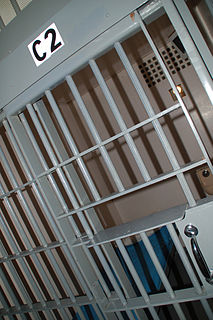Related Research Articles

Human Rights Watch (HRW) is an international non-governmental organization, headquartered in New York City, that conducts research and advocacy on human rights. The group pressures governments, policy makers, companies, and individual human rights abusers to denounce abuse and respect human rights, and the group often works on behalf of refugees, children, migrants, and political prisoners.
Prison sexuality consists of sexual relationships between prisoners or between a prisoner and a prison employee or other persons to whom prisoners have access. Since prisons are usually separated by gender, most sexual activity is with a same-sex partner. Exceptions to this consist of sex during conjugal visits and sex with an employee of the opposite sex or sometimes the same sex.
A significant proportion of victims of rape or other sexual violence incidents are male. Historically, rape was thought to be, and defined as, a crime committed solely against women. This belief is still held in some parts of the world, but rape of males is now commonly criminalized and has been subject to more discussion than in the past.
Marital rape or spousal rape is the act of sexual intercourse with one's spouse without the spouse's consent. The lack of consent is the essential element and need not involve physical violence. Marital rape is considered a form of domestic violence and sexual abuse. Although, historically, sexual intercourse within marriage was regarded as a right of spouses, engaging in the act without the spouse's consent is now widely classified as rape by many societies around the world, repudiated by international conventions, and increasingly criminalized.
Prison rape commonly refers to the rape of inmates in prison by other inmates or prison staff. In 2001, Human Rights Watch estimated that at least 4.3 million inmates had been raped while incarcerated in the United States. A United States Department of Justice report, Sexual Victimization in Prisons and Jails Reported by Inmates, states that "In 2011–12, an estimated 4.0% of state and federal prison inmates and 3.2% of jail inmates reported experiencing one or more incidents of sexual victimization by another inmate or facility staff in the past 12 months or since admission to the facility, if less than 12 months." However, advocates dispute the accuracy of the numbers, saying they seem to under-report the real numbers of sexual assaults in prison, especially among juveniles.

The Prison Rape Elimination Act of 2003 (PREA) is the first United States federal law intended to deter the sexual assault of prisoners. The bill was signed into law on September 4, 2003.

Prisoner abuse is the mistreatment of persons while they are under arrest or incarcerated. Prisoner abuse can include physical abuse, psychological abuse, sexual abuse, torture, or other acts such as refusal of essential medication.
Rape can be categorized in different ways: for example, by reference to the situation in which it occurs, by the identity or characteristics of the victim, and by the identity or characteristics of the perpetrator. These categories are referred to as types of rape. The types of rape described below are not mutually exclusive: a given rape can fit into multiple categories, by for example by being both a prison rape and a gang rape, or both a custodial rape and the rape of a child.
Rape by gender classifies types of rape by the sex and/or gender of both the rapist and the victim. This scope includes both rape and sexual assault more generally. Most research indicates that rape affects women disproportionately, with the majority of people convicted being men; however, since the broadening of the definition of rape in 2012 by the FBI, more attention is being given to male rape, including females raping males.

The James V. Allred Unit is a prison for males located on Farm to Market Road 369 in Wichita Falls, Texas, United States, 4 miles (6.4 km) northwest of downtown Wichita Falls. The prison is near Iowa Park. The prison, with about 320 acres (130 ha) of land, is a part of the Texas Department of Criminal Justice Region V.

Angola has long been severely criticized for its human rights record. A 2012 report by the U.S. Department of State said, "The three most important human rights abuses [in 2012] were official corruption and impunity; limits on the freedoms of assembly, association, speech, and press; and cruel and excessive punishment, including reported cases of torture and beatings as well as unlawful killings by police and other security personnel. Other human rights abuses included: harsh and potentially life-threatening prison conditions; arbitrary arrest and detention; lengthy pretrial detention; impunity for human rights abusers; lack of judicial process and judicial inefficiency; infringements on citizens' privacy rights and forced evictions without compensation; restrictions on nongovernmental organizations; discrimination and violence against women; abuse of children; trafficking in persons; discrimination against persons with disabilities, indigenous people, and persons with HIV/AIDS; limits on workers' rights; and forced labor."

The National Prison Rape Elimination Commission (NPREC) was a U.S. bipartisan panel established by the 2003 Prison Rape Elimination Act. The commission was charged with studying sexual assaults in U.S. jails and prisons and presenting a report based on its findings.

Lesbian, gay, bisexual, and transgender (LGBT) prisoners often face additional challenges compared to non-LGBT prisoners. According to Just Detention International, LGBT inmates are "among the most vulnerable in the prison population". 67% of LGBT prisoners in California report being assaulted while in prison. The vulnerability of LGBT prisoners has led some prisons to separate them from other prisoners, while in others they are housed with the general population.
Farmer v. Brennan, 511 U.S. 825 (1994), was a case in which the Supreme Court of the United States ruled that a prison official's "deliberate indifference" to a substantial risk of serious harm to an inmate violates the cruel and unusual punishment clause of the Eighth Amendment. Farmer built on two previous Supreme Court decisions addressing prison conditions, Estelle v. Gamble and Wilson v. Seiter. The decision marked the first time the Supreme Court directly addressed sexual assault in prisons.

Prison rape or jail rape is rape occurring in prison. The phrase is commonly used used to describe rape of inmates by other inmates, less commonly to the rape of inmates by staff, and rarely to rape of staff by inmates.
Jamie Fellner is senior counsel for the United States Program of Human Rights Watch. The U.S. Program focuses on human rights violations within the United States. From 2004-09, she also served on the U.S. National Prison Rape Elimination Commission.

The rate of sexual violence in South Africa is among the highest in the world. Sexual violence is the use of force or manipulation to get someone to engage in unwanted sexual activity without their consent. During 2015/16, there were 51,895 crimes of a sexual nature reported to the South African Police Service.

Rodney Hulin Jr. committed suicide by hanging in the Clemens Unit in unincorporated Brazoria County, Texas on January 26, 1996 after being raped in prison; Hulin died months after he fatally injured himself. Hulin became a symbol of a movement that advocated not placing juvenile offenders in adult institutions.

The Julia Tutwiler Prison for Women is a prison for women of the Alabama Department of Corrections (ADOC), located in Wetumpka, Alabama. All female inmates entering ADOC are sent to the receiving unit in Tutwiler. Tutwiler houses Alabama's female death row, which qualifies it for the "maximum security" classification.
The Kashmir Conflict has been characterized by large scale usage of sexual violence by multiple belligerents since its inception.
References
- 1 2 Smith, Brenda V. (Spring 2008). "The Prison Rape Elimination Act: Implementation and Unresolved Issues". Criminal Law Brief. Washington College of Law (WCL Research Paper No. 2008–49). OCLC 63521701. SSRN 1129810 .
- 1 2 "Rape in Prison". The New York Times . 2001-04-22. Retrieved 2008-06-07.
- 1 2 3 Lewin, Tamar (2001-04-15). "Little sympathy or remedy for inmates who are raped". The New York Times . Retrieved 2008-06-07.
- 1 2 3 4 5 Coolman, Alex (May 2003). "No Escape: Male Rape in U.S. Prisons". Prison Legal News. via Stop Prisoner Rape, Inc. ISSN 1075-7678.
- ↑ Mariner, Joanne (2001). "Acknowledgements". No Escape: Male Rape in U.S. Prisons. Human Rights Watch . Retrieved 2008-06-07.
- ↑ "Rape Crisis in U.S. Prisons" (Press release). Human Rights Watch. 2001-04-19. Retrieved 2008-06-07.
- 1 2 3 Staples, Brent (2004-11-27). "The Federal Government Gets Real About Sex Behind Bars". The New York Times . Retrieved 2008-06-07.
- ↑ Bell, Dan (2006-06-21). "They Deserve It". The Nation (2008–07–10). ISSN 0027-8378. OCLC 1643268 . Retrieved 2008-06-07.
- 1 2 "Preventing prison rape". St. Petersburg Times . 2003-08-29. Retrieved 2008-06-07.
- 1 2 Liptak, Adam (2004-10-16). "Ex-Inmate's Suit Offers View Into Sexual Slavery in Prisons". The New York Times . Retrieved 2008-06-07.
- ↑ "ACLU Says Faulty Investigation by Texas Corrections Department Led to Grand Jury's Failure to Indict Rape Suspects" (Press release). American Civil Liberties Union. 2004-02-26. Retrieved 2008-06-07.
- ↑ Austin, James; Fabelo, Tony; Gunter, Angela; McGinnis, Ken (March 2006). "Sexual Violence in the Texas Prison System" (PDF). The JFA Institute. Retrieved 2008-06-07.
- ↑ "Texas Update: Texas State Prisons Plagued by Sexual Abuse" (PDF). Stop Prisoner Rape, Inc. March 2008. Retrieved 2008-06-07.
- ↑ "No Escape: Male Rape in US Prisons -- Human Rights Watch". The Scout Report for Social Sciences & Humanities; Volume 4, Number 17. Internet Scout Project, Computer Sciences Department, University of Wisconsin–Madison. 2001-05-01. Retrieved 2008-06-07.
- ↑ "Public Law 108-79, September 4, 2003 (Prison Rape Elimination Act of 2003)". Office of Juvenile Justice and Delinquency Programs, United States Department of Justice. 2003-09-04. Archived from the original on May 26, 2008. Retrieved 2008-06-07.
- ↑ Teret, Stephen P.; Julie Samia Mair; Shannon Frattaroli (Winter 2003). "New Hope for Victims of Prison Sexual Assault" (PDF). The Journal of Law, Medicine & Ethics. American Society of Law, Medicine & Ethics via Stop Prisoner Rape, Inc. 31 (4): 602–6. doi:10.1111/j.1748-720x.2003.tb00127.x. ISSN 1073-1105. PMID 14968662. S2CID 6502779 . Retrieved 2008-06-06.